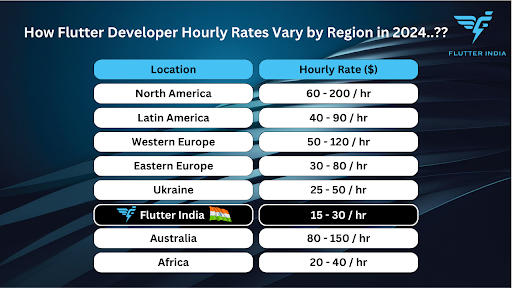The Cost of Hiring Flutter Developers in 2024: What You Need to Know
- Kritika Verma
- October 30, 2024
- 5 Minute Read

Flutter is a powerful tool to build cross-platform, high-performance apps, saving both time and money. It performs much like native apps, which increases user satisfaction.
The architecture of Flutter allows better app management and scalability as companies expand. This flexibility is one of the main reasons that companies want to hire Flutter developers in 2024.
As the demand for Flutter developers is rising, companies need to find ways so that they don’t have to break the bank to get skilled developers to work with. Hence, determining the cost of hiring Flutter developers is a must for stakeholders. Proper budgeting ensures resource allocation and helps with calculating ROI.
Team capacities, project complexity, and ongoing maintenance can all significantly influence overall expenditures. Understanding these components enables businesses to make sound choices that correspond with their financial objectives while welcoming Flutter’s capabilities to improve their applications.
Factors Affecting the Cost of Hiring Flutter Developers
When estimating the cost of hiring Flutter developers, various factors come into play. These aspects have a big impact on the entire budget and should be carefully considered to achieve a successful project.
Developer Experience and Expertise
Experienced developers demand higher salaries because of their skills and track records.
A Flutter developer with over five years of experience and a varied portfolio of projects spanning many technologies will typically charge more.
Geographic Location
The cost of hiring Flutter developers in 2024 will vary according to geographic location.
If a company is situated in a major technology hub, like Bangalore, India, the hiring management team can face slightly higher costs because of the city’s demand for skilled developers and high cost of living. In 2024, the cost of a Flutter developer in Bangalore is Rs. 5.8 LPA.
Project Complexity and Scope
Projects with complex needs or multiple features will demand more resources, raising overall development costs.
For example, if a project requires extensive database logic—such as advanced querying, real-time data synchronization, or processing big datasets—the development process becomes substantially more demanding, eventually increasing the hiring cost as well.
Full-Time vs. Freelance Developers
Hiring full-time developers usually results in higher upfront costs, whereas freelancers can offer more flexibility but vary in availability, reliability, and the complexity of the project.
Hourly Rates for Flutter Developers
Understanding pay rates of flutter developers‘ hourly rates is important when calculating a Flutter development budget. The costs might vary widely depending on criteria such as experience, region, and market demand.

Global Average Rates
The global average hourly rate for Flutter developers is from $30 and $150, depending on experience and location. This vast diversity reflects different markets and worldwide demand for skilled developers.
Region-Specific Rate Analysis
In North America, hourly prices can range between $200 to $250, showing strong demand and costs of living.
In comparison, junior developers in Asia, particularly in countries like India, may charge between $20 and $30 per hour, and for senior developers charge falls between $50 and $60, offering a more affordable alternative for businesses seeking to recruit Flutter developers.
Comparing Rates of Junior, Mid-Level, and Senior Developers
Junior developers with less than two years of experience often charge lower rates, ranging from $30 to $50 per hour. Mid-level developers may charge $50 to $60 per hour, and senior developers with years of expertise can charge up to $150 per hour.
Project-Based Costs
When budgeting for the hiring costs of a Flutter developer, it is crucial to consider project-based expenses, which might vary significantly depending on the project’s size.
Understanding these expenses can help organizations use resources more effectively.
Small-Scale Projects
Small-scale projects, including small mobile applications with minimal functionality, developers often cost between $250 and $350.
Medium-Scale Projects
Medium-scale projects, which can involve more complicated features like integrations and customized UI design, developers often ask from $550 to $1,550.
- Large-Scale Projects
For large-scale projects, such as enterprise-level apps or those with extensive functionality and heavy user traffic, developers can demand $1,200 – $4,800.
Hidden Costs to Consider
It’s important to include hidden costs when creating a budget for Flutter development, as these might have significant impacts on the project’s total cost.
Onboarding and Training

Bringing new developers on board a project sometimes involves onboarding and training costs, especially if they have to familiarize themselves with the project’s complexities or the company’s procedure.
According to Glassdoor, the cost of onboarding a new employee can reach up to $4,000 or more.
Communication and Collaboration Tools
Investing in good communication and collaboration tools is vital for teamwork, particularly among remote workers. These tools, be it for project management like Jira or ClickUp, require subscriptions like $7-$14, which add to the entire project cost.
Revisions and Maintenance
Frequent client revisions or heavy changes might result in higher costs. Also, continuing maintenance after the app’s launch to maintain performance and security can be a significant investment that should be planned from the very start.
According to industry standards, the overall cost of app maintenance is between 15% and 20% of the initial development costs. It depends on many factors, for example, server cost, push notification, payment gateway, app store fee, etc.
How to Optimize Costs
Businesses can consider several strategies to make use of resources while cutting expenses in Flutter development.
Hiring Strategies
The decision between in-house development and remote teams can have an important impact on expenses.
While in-house teams can encourage greater collaboration, incorporating remote teams is typically more cost-effective, especially when looking to hire Flutter developers in lower living-cost locations.
Leveraging Open-Source Tools and Libraries
Using open-source tools and libraries can cut development time as well as costs since many high-quality resources are free. This method helps developers to focus on customization and unique features rather than recreating the wheel.
Effective Project Management
Implementing effective project management helps improve activities in the project scope, causing time and cost savings. Agile methods like Jira, Trello, and ClickUp can improve communication and collaboration throughout the teams, putting projects on track and within budget.
Trends in Flutter Development and Their Impact on Costs
As Flutter advances, several trends influence the development environment and impact employment costs. Understanding these trends can help organizations make better budget and resource allocation decisions.
Advances in Flutter Technology
Recent developments, such as better features and tooling, simplify the development process, potentially lowering total project costs. As Flutter becomes more comprehensive, developers will be able to produce excellent applications more quickly and effectively.
Increasing Demand for Flutter Skills
With the rising popularity of Flutter among businesses looking for cross-platform solutions, the demand for professional Flutter developers is on the rise. As businesses compete for skilled developers, the increasing demand can end up in higher hourly costs.
Economic Factors Influencing Developer Rates
Global economic trends, including inflation and job market changes, can influence developers’ hourly rates. Hiring costs may rise during economic expansion due to increased competition for qualified developers.
Conclusion
Understanding the costs related to Flutter development is essential if you want proper budgeting for your organization. The costs include developer experience, project complexity, geographic location, project size, and so on.
Think about setting up a reserve fund to cover unforeseen expenses. Also, thoroughly interviewing potential developers and outlining project needs in advance can reduce surprises later on.

Thank you for submitting the details!
We will keep your information safe. Feel free to contact us with any questions at hello@uplers.com
Please check your email for next steps shared by Robert.

















